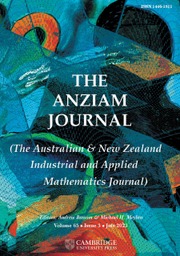No CrossRef data available.
Article contents
AN ANALYTIC SOLUTION FOR ONE-DIMENSIONAL DISSIPATIONAL STRAIN-GRADIENT PLASTICITY
Published online by Cambridge University Press: 03 November 2009
Abstract
An analytic solution is developed for the one-dimensional dissipational slip gradient equation first described by Gurtin [“On the plasticity of single crystals: free energy, microforces, plastic strain-gradients”, J. Mech. Phys. Solids48 (2000) 989–1036] and then investigated numerically by Anand et al. [“A one-dimensional theory of strain-gradient plasticity: formulation, analysis, numerical results”, J. Mech. Phys. Solids53 (2005) 1798–1826]. However we find that the analytic solution is incompatible with the zero-sliprate boundary condition (“clamped boundary condition”) postulated by these authors, and is in fact excluded by the theory. As a consequence the analytic solution agrees with the numerical results except near the boundary. The equation also admits a series of higher mode solutions where the numerical result corresponds to (a particular case of) the fundamental mode. Anand et al. also established that the one-dimensional dissipational gradients strengthen the material, but this proposition only holds if zero-sliprate boundary conditions can be imposed, which we have shown cannot be done. Hence the possibility remains open that dissipational gradient weakening may also occur.
MSC classification
Information
- Type
- Research Article
- Information
- The ANZIAM Journal , Volume 50 , Issue 3: This Special Issue is dedicated to Dr Stephen White , January 2009 , pp. 407 - 420
- Copyright
- Copyright © Australian Mathematical Society 2009

